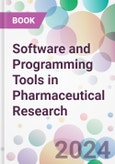The book includes nine structured chapters, each addressing a critical aspect of pharmaceutical research and software utilization. From an introduction to pharmaceutical informatics and computational chemistry to advanced topics like molecular modeling, data mining, and high-throughput screening, this book covers a wide range of topics.
Key Features:
- Practical Insights: Presents practical knowledge on how to effectively utilize software tools in pharmaceutical research.
- Interdisciplinary Approach: Bridges the gap between pharmaceutical science and computer science
- Cutting-Edge Topics: Covers the latest advancements in computational drug development, including data analysis and visualization techniques, drug repurposing, pharmacokinetic modelling and screening.
- Recommendations for Tools: Includes informative tables for software tools
- Referenced content: Includes scientific references for advanced readers
Readership
Pharmaceutical researchers, scientists, and professionals; students and educators in pharmacology and computational biology.Table of Contents
CHAPTER 1 INTRODUCTION TO COMPUTER-BASED SIMULATIONS AND- METHODOLOGIES IN PHARMACEUTICAL RESEARCH
- Samaresh Pal Roy
1.1. Types of Computer-Based Simulations in Pharmaceutical Research
1.1.1. Challenges and Limitations of Computer-Based Simulations
1.1.2. Advances in Computer-Based Simulations
2. MOLECULAR MODELLING: PRINCIPLES AND APPLICATIONS IN DRUG
- DISCOVERY
2.2. Applications of Molecular Modelling in Drug Discovery
2.3. Molecular Modeling Techniques
3. COMPUTER-AIDED DRUG DESIGN: CONCEPTS AND TECHNIQUES
3.1. Principles of Computer-Aided Drug Design
3.1.1. Virtual Screening
3.2. Applications of Computer-Aided Drug Design in Drug Discovery
3.2.1. Computer-Aided Drug Design Techniques
3.2.2. Molecular Docking: Predicting Protein-ligand Interactions
3.2.3. Quantitative Structure-Activity Relationship (QSAR) Modeling
3.2.4. Virtual Screening: Accelerating Drug Discovery Through Computational
- Techniques
- CONCLUSION
- ACKNOWLEDGEMENT
- REFERENCES
- THEIR PREDICTIVE PROPERTIES
- Ram Babu S., Sakshi T. and Amardeep K.
2. THEORIES OF DISSOLUTION
2.1. The Diffusion Layer Model
2.2. The Interfacial Barrier Model
2.3. Danckwert’s Model
3. IVIVC (IN VITRO - IN VIVO CORRELATION) STUDIES
4. EXPERIMENTAL TECHNIQUES FOR DISSOLUTION
5. FUNDAMENTALS OF DISSOLUTION TESTING
5.1. Signifance of Dissolution Testing
5.2. Product Stability
5.3. Comparability Assessment
5.4. Noyes-Whitney Rule
5.5. Nernst and Brunner Film Theory
6. MATHEMATICAL AND STATISTICAL TOOLS FOR IN VITRO DISSOLUTION
- METHODS
6.2. Empirical and Semi-empirical Mathematical Modeling
6.2.1. Zero order Kinetics
6.2.2. First-order Kinetics
6.2.3. Higuchi Model
6.2.4. Hixson- Crowell Model
6.2.5. Korsmeyer-Peppas Model
6.2.6. Baker Lonsdale Model
6.2.7. Weibull Model
6.2.8. Hopfenberg Model
7. PREDICTION OF IN VITRO DISSOLUTION STUDIES USING ADVANCED
- MEASUREMENTS TECHNIQUES
- CONCLUSION
- CONSENT FOR PUBLICATON
- CONFLICT OF INTEREST
- ACKNOWLEDGEMENT
- REFERENCES
- PHARMACEUTICAL RESEARCH: CURRENT ADVANCES
- Diksha Sharma, Anjali Sharma, Punam Gaba, Neelam Sharma, Rahul Kumar
- Sharma and Shailesh Sharma
1.1. Definition of PCA
1.1.1. Definition
1.1.2. Goals
1.2. History of PCA
2. TERMINOLOGY IN THE PCA ALGORITHM
2.1. Dimensionality
2.2. Correlation
2.3. Orthogonal
2.4. Eigenvectors
2.5. Covariance Matrix
2.6. The PCA Algorithm's Steps
2.6.1. Getting the Dataset
2.6.2. Structure of Representing Data
2.6.3. Standardizing the data
2.6.4. Covariance of Z
2.6.5. Eigenvalues and Eigenvectors
2.6.6. Sorting the Eigenve+-ctors
2.6.7. Calculating the New Features
2.6.8. Unimportant Features from the New Data
2.7. PCA for Feature Engineering
2.7.1. Dimensionality Reduction
2.7.2. Anomaly Detection
2.7.3. Noise Reduction
2.7.4. Decorrelation
2.8. Role of Principal Component Analysis in Pharmaceutical Research
2.8.1. Covariance
2.8.2. Eigen vectors and eigen values
2.9. PCA in Drug Excipients Interaction Studies
2.10. Role of PCA in Various Pharmaceutical Fields
2.10.1. Adaptations
2.10.2. Functional PCA
2.10.3. Simplified PCA
2.11. Symbolic Data Principal Component Analysis
2.11.1. Advantages of PCA
2.11.2. Disadvantages of PCA
2.12. Software’s used to Perform Principal Component Analysis
3. APPLICATIONS OF PCA IN PHARMACEUTCAL RESEARCH
3.1. Neuroscience
3.2. Role of PCA in Drug Discovery
3.3. Image Recognition
3.3.1. Advantages
3.4. QSAR Studies
4. MEDICAL DATA IN PCA REPOSITORIES
4.1. As Sensory Assessment Tool for Fermented Food Products
4.2. In Nanomaterials
4.3. Bimolecular Molecule Dynamics
4.4. ECG Signal Determination
- CONCLUSION
- REFERENCES
- ADVANCES AND FUTURE PROSPECTS
- Popat Mohite, Amol Gholap, Sagar Pardeshi, Abhijeet Puri and Tanavirsing Rajput
1.1. Conventional Approach vs Design Approach
1.2. QbD Paradigm and Regulatory Authorities
1.3. Contribution of Ishikawa Diagram
1.4. Impact of FEMA on Quality Improvement
1.5. RRMA into QbD and Process Failures
1.6. Role of CQA, KPI and CPP within QbD
2. ICH Q8 PHARMACEUTICAL DEVELOPMENT
2.1. Overview of ICH Q8 (R2) Pharmaceutical Development
2.2. Quality by Testing Approach vs QbD Approach
2.3. QbD Elements in Pharmaceutical Development
2.4. Formulation Development
3. QUALITY BY DESIGN (QBD) TOOLS: APPLICATION IN PRODUCT
- DEVELOPMENT
3.2. Critical Material Attributes (CMA’s), Critical Material Parameters (CPPs), and Critical
- Quality Attributes (CQA’s)
3.4. Design of Experiment (DOE) and Design Space
3.5. Control Strategy
3.5.1. Process Analytical Technology (PAT)
4. QUALITY-BY-DESIGN: CURRENT TRENDS IN PHARMACEUTICAL
- DEVELOPMENT
- PROCEDURES
5.2. Risk Analysis
5.3. Risk Evaluation
6. QBD IN PHARMACEUTICAL DEVELOPMENT
Author
- Dilpreet Singh
- Prashant Tiwari








